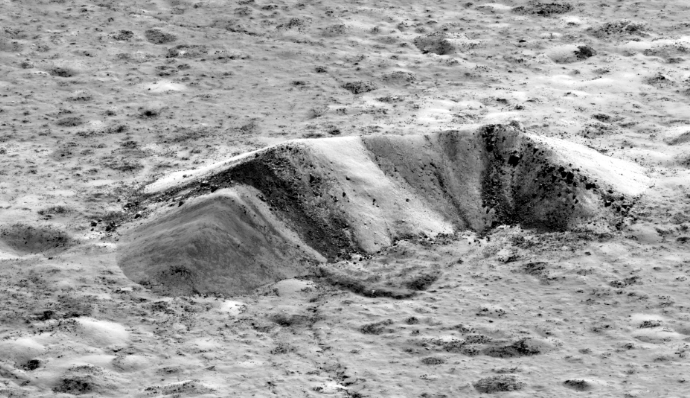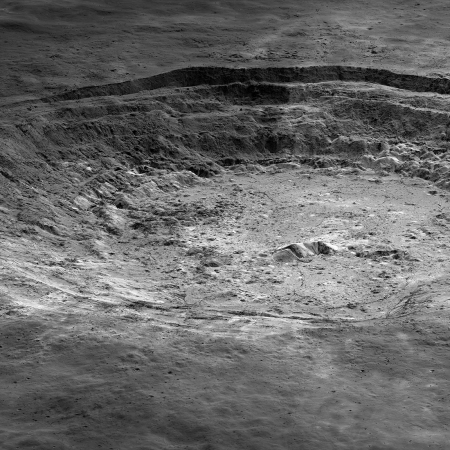Aristarchus Crater on the Moon
Cool image time! The image on the right, reduced in resolution to post here, shows Aristarchus Crater, one of the more geological intriguing locations on the Moon. This oblique image was taken by Lunar Reconnaissance Orbiter (LRO), still operating in lunar orbit. If you click on the image you can see the full resolution image.
Aristarchus crater is 40 kilometers (25 miles) in diameter and 2700 meters (1.7 miles) deep, with a central peak that rises 300 meters (almost a thousand feet) above the crater floor. When LRO pointed back towards the Sun, LROC was able to capture this magnificent view highlighting subtle differences in albedo (brightness). Some of the albedo contrast is due to maturity (young material is generally brighter than older material) and some reveal true differences in rock type. The central peak shows the complexity of what lies beneath the now hardened impact melt sea that filled the bottom of the crater.
The best part however is the close-up they provided of the crater’s central peaks, posted below.

The number of fascinating features in this one image is astonishing. As noted by the LRO science team, “The banding seen in the central peak (3200 meters wide, 300 meters tall) is due to different rock types exposed during the impact event.” You can see this banding going up one side of the mountain and down its other side.
There are also a lot of boulders at the mountain’s base, as well as scattered on its slopes. The crater floor surrounding the central peak is also clearly impact melt, with fractures and cracks suggesting the possibility of underground voids. You can see one such fracture on the peak’s near side in the center of the image. The peak also features the crater’s unusually bright and dark features, seen also in this earlier LRO image.
The region around Aristachus contains lots of evidence of relatively recent volcanic activity. Over the decades astronomers have even thought they have detected flashes in this region. The region also contains a major rill flowing away from the crater.
Sadly, the Apollo mission that would have landed here was cancelled, and thus Aristarchus remains one of the prime landing sites for future exploration.
On Christmas Eve 1968 three Americans became the first humans to visit another world. What they did to celebrate was unexpected and profound, and will be remembered throughout all human history. Genesis: the Story of Apollo 8, Robert Zimmerman's classic history of humanity's first journey to another world, tells that story, and it is now available as both an ebook and an audiobook, both with a foreword by Valerie Anders and a new introduction by Robert Zimmerman.
The print edition can be purchased at Amazon or from any other book seller. If you want an autographed copy the price is $60 for the hardback and $45 for the paperback, plus $8 shipping for each. Go here for purchasing details. The ebook is available everywhere for $5.99 (before discount) at amazon, or direct from my ebook publisher, ebookit. If you buy it from ebookit you don't support the big tech companies and the author gets a bigger cut much sooner.
The audiobook is also available at all these vendors, and is also free with a 30-day trial membership to Audible.
"Not simply about one mission, [Genesis] is also the history of America's quest for the moon... Zimmerman has done a masterful job of tying disparate events together into a solid account of one of America's greatest human triumphs."--San Antonio Express-News
Cool image time! The image on the right, reduced in resolution to post here, shows Aristarchus Crater, one of the more geological intriguing locations on the Moon. This oblique image was taken by Lunar Reconnaissance Orbiter (LRO), still operating in lunar orbit. If you click on the image you can see the full resolution image.
Aristarchus crater is 40 kilometers (25 miles) in diameter and 2700 meters (1.7 miles) deep, with a central peak that rises 300 meters (almost a thousand feet) above the crater floor. When LRO pointed back towards the Sun, LROC was able to capture this magnificent view highlighting subtle differences in albedo (brightness). Some of the albedo contrast is due to maturity (young material is generally brighter than older material) and some reveal true differences in rock type. The central peak shows the complexity of what lies beneath the now hardened impact melt sea that filled the bottom of the crater.
The best part however is the close-up they provided of the crater’s central peaks, posted below.

The number of fascinating features in this one image is astonishing. As noted by the LRO science team, “The banding seen in the central peak (3200 meters wide, 300 meters tall) is due to different rock types exposed during the impact event.” You can see this banding going up one side of the mountain and down its other side.
There are also a lot of boulders at the mountain’s base, as well as scattered on its slopes. The crater floor surrounding the central peak is also clearly impact melt, with fractures and cracks suggesting the possibility of underground voids. You can see one such fracture on the peak’s near side in the center of the image. The peak also features the crater’s unusually bright and dark features, seen also in this earlier LRO image.
The region around Aristachus contains lots of evidence of relatively recent volcanic activity. Over the decades astronomers have even thought they have detected flashes in this region. The region also contains a major rill flowing away from the crater.
Sadly, the Apollo mission that would have landed here was cancelled, and thus Aristarchus remains one of the prime landing sites for future exploration.
On Christmas Eve 1968 three Americans became the first humans to visit another world. What they did to celebrate was unexpected and profound, and will be remembered throughout all human history. Genesis: the Story of Apollo 8, Robert Zimmerman's classic history of humanity's first journey to another world, tells that story, and it is now available as both an ebook and an audiobook, both with a foreword by Valerie Anders and a new introduction by Robert Zimmerman.
The print edition can be purchased at Amazon or from any other book seller. If you want an autographed copy the price is $60 for the hardback and $45 for the paperback, plus $8 shipping for each. Go here for purchasing details. The ebook is available everywhere for $5.99 (before discount) at amazon, or direct from my ebook publisher, ebookit. If you buy it from ebookit you don't support the big tech companies and the author gets a bigger cut much sooner.
The audiobook is also available at all these vendors, and is also free with a 30-day trial membership to Audible.
"Not simply about one mission, [Genesis] is also the history of America's quest for the moon... Zimmerman has done a masterful job of tying disparate events together into a solid account of one of America's greatest human triumphs."--San Antonio Express-News



I have to say, these are some of the best and most compelling in detail photos that you have ever posted. Very interesting!
Don’t tell Richard Hoagland, but that’s a pit quarry.
Just kidding.
This is a perfect forensic study of how a crater is formed upon an impact on the moon, you can see with little ambiguity the entire process, beginning to end, with what remains that is shown in this one picture.
If you zoom in on the very bottom of the image you can see the HUNDREDS of micro-meteorite impact craters.
It’s no joke that habitats will have to be below the surface! None of that glass dome silliness from all the sci-fi movies and such…
Thank you, Bob. These are some of the most impressive outer space photos I’ve ever seen
@BSJ
Well, those micro meteoroids have impacted during hundreds of millions of years. So if you imagine away 99.999999% of them, that would be you risk of impact during a lifetime standing there. (You will of course find worse things to worry about than that, given human nature)
And btw, I estimate your lifetime on the Moon to one year in my digits above. But for very other reasons than micro meteoroids. :-D
Glass dome helmets will be fine, though. But I think that strolling in the parks won’t be as much of a social gathering as was at the avenues in Paris and Vienna. That ind of stuff will kill of colonization. Not some traffic accidents, evidently everyone simply accept them and go on.
The Perseid meteor shower is this weekend. At a rate of 60 to 70 an hour, at 60 km/s! Undoubtedly, they will also be striking the Moon.
I’ll gladly stay inside the Earth’s atmosphere, than you!
BSJ,
Another reason to build below ground, or at least cover manned structures with regolith, is the radiation environment. Windows overlooking the lunar landscape will be small, few, and far between.
You also want to build underground because it mitigates the wild temperature swings seen on the surface. Your environmental systems on the moon will have less stress dealing with one year-round temperature, rather than 300 to 600 degree temperature changes from day to night.
Elon Musk wouldn’t run The Boring Company if he didn’t plan for building his Mars colony underground. He doesn’t do anything that isn’t of direct use on Mars (SpaceX, Solar power, batteries, electric vehicles, communication satellites, drilling, vacuum engineering of the Hyperloop). I don’t think that drilling has any other advantages than being a cheap way of interplanetary construction. Getting rid of the material in place instead of launching material there.